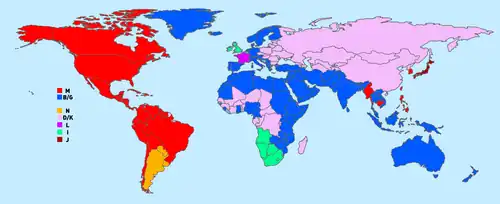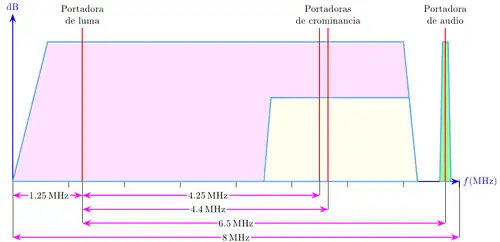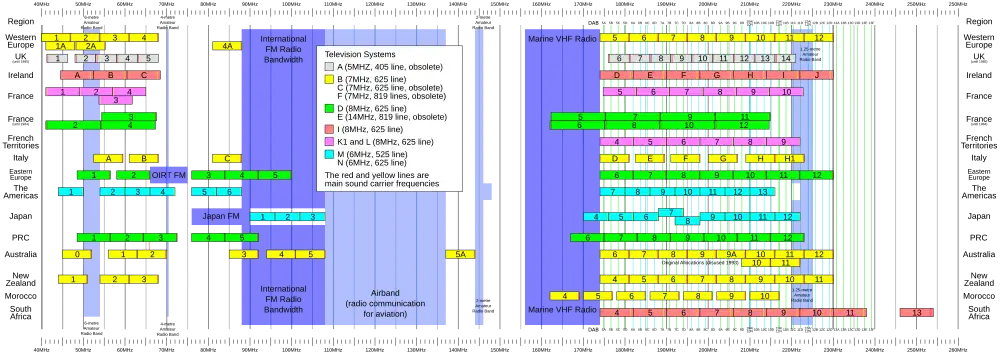CCIR System L

CCIR System L is an analog broadcast television system used in France, Luxembourg, Monaco, and Chausey.[1][2][3] It was the last system to use positive video modulation and AM sound.[3]
Initially adopted in 1963 for second national black and white public channel and officially associated with the SECAM color system (SECAM-L) in 1967, it was discontinued in 2011, when France transitioned to Digital Video Broadcasting.
Specifications

The main System L specifications are listed below:[4][1][5]
- Frame rate: 25 Hz
- Interlace: 2/1
- Field rate: 50 Hz
- Lines/frame: 625
- Line rate: 15.625 kHz
- Visual bandwidth: 6 MHz
- Vision modulation: Positive
- Preemphasis: 50 μs
- Sound modulation: AM
- Sound offset: -6.5 MHz
- Channel bandwidth: 8 MHz

Television channels were arranged as follows:[6][7]
| Channel | Video carrier (MHz) | Audio carrier (MHz) |
|---|---|---|
| 1 | 47.75 | 41.25 |
| 2 | 55.75 | 49.25 |
| 3 | 60.50 | 54.00 |
| 4 | 63.75 | 57.25 |
| 5 | 176.00 | 182.50 |
| 6 | 184.00 | 190.50 |
| 7 | 192.00 | 198.50 |
| 8 | 200.00 | 206.50 |
| 9 | 208.00 | 214.50 |
| 10 | 216.00 | 222.50 |
| Channel | Video carrier (MHz) | Audio carrier (MHz) |
|---|---|---|
| 21 | 471.25 | 477.75 |
| 22 | 479.25 | 485.75 |
| 23 | 487.25 | 493.75 |
| 24 | 495.25 | 501.75 |
| 25 | 503.25 | 509.75 |
| 26 | 511.25 | 517.75 |
| 27 | 519.25 | 525.75 |
| 28 | 527.25 | 533.75 |
| 29 | 535.25 | 541.75 |
| 30 | 543.25 | 549.75 |
| 31 | 551.25 | 557.75 |
| 32 | 559.25 | 565.75 |
| 33 | 567.25 | 573.75 |
| 34 | 575.25 | 581.75 |
| 35 | 583.25 | 589.75 |
| 36 | 591.25 | 597.75 |
| 37 | 599.25 | 605.75 |
| 38 | 607.25 | 613.75 |
| 39 | 615.25 | 621.75 |
| 40 | 623.25 | 629.75 |
| 41 | 631.25 | 637.75 |
| 42 | 639.25 | 645.75 |
| 43 | 647.25 | 653.75 |
| 44 | 655.25 | 661.75 |
| 45 | 663.25 | 669.75 |
| 46 | 671.25 | 677.75 |
| 47 | 679.25 | 685.75 |
| 48 | 687.25 | 693.75 |
| 49 | 695.25 | 701.75 |
| 50 | 703.25 | 709.75 |
| 51 | 711.25 | 717.75 |
| 52 | 719.25 | 725.75 |
| 53 | 727.25 | 733.75 |
| 54 | 735.25 | 741.75 |
| 55 | 743.25 | 749.75 |
| 56 | 751.25 | 757.75 |
| 57 | 759.25 | 765.75 |
| 58 | 767.25 | 773.75 |
| 59 | 775.25 | 781.75 |
| 60 | 783.25 | 789.75 |
| 61 | 791.25 | 797.75 |
| 62 | 799.25 | 805.75 |
| 63 | 807.25 | 813.75 |
| 64 | 815.25 | 821.75 |
| 65 | 823.25 | 829.75 |
| 66 | 831.25 | 837.75 |
| 67 | 839.25 | 845.75 |
| 68 | 847.25 | 853.75 |
| 69 | 855.25 | 861.75 |
See also
Notes and references
- ^ a b Documents of the XIth Plenary Assembly - Oslo, 1966 - Volume V - Sound Broadcasting Television (PDF). International Telecommunication Union. 1967.
- ^ "World Analogue Television Standards and Waveforms". 30 August 2012. Archived from the original on 30 August 2012.
- ^ a b "Weltweite Fernsehsysteme (NTSC, PAL und SECAM)". www.paradiso-design.net. 2019. Archived from the original on 9 December 2012. Retrieved 2023-03-06.
- ^ Reference Data for Radio Engineers, ITT Howard W.Sams Co., New York, 1977, section 30
- ^ "World Analogue Television Standards and Waveforms". 2007-05-15. Archived from the original on 2007-05-15. Retrieved 2023-04-13.
- ^ "CCIR Systems - Radio Channels: System-L - France". www.pembers.freeserve.co.uk. Archived from the original on 30 August 2012. Retrieved 12 January 2022.
- ^ "CCIR Systems - Radio Channels: Systems B, D, G, I, K, L 625 lines 7/8MHz, cable distribution, Europe". www.pembers.freeserve.co.uk. Archived from the original on 30 August 2012. Retrieved 12 January 2022.